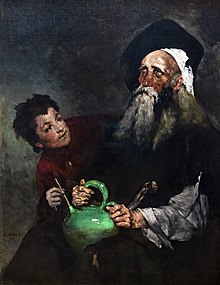Hispagnolisme

Hispagnolisme (French: espagnolisme ⓘ) is the inordinate love of all things Spanish, a craze for which spread through French society, and much of the associated art world, in the 19th century.
Origins[edit]
Hispagnolisme first began to emerge in the 18th century, as seen in figures like Fragonard.[1] It received a powerful impetus from Napoleon's Spanish campaigns, during the Peninsular War;[2] and took off fully in French society in and after the 1830s.[3]
Apex[edit]
Writers like Merimee, and musicians like Bizet,[4] profited from, and also helped foster, Hispagnolisme; as did such painters as Manet,[5] with his Spanish-derived masterpiece Le Déjeuner sur l’herbe.[6]
In Britain, hispagnolisme had an influence on artists such as Sargent.[7]
Hispagnolisme was still powerful enough in Paris at the close of the century for Pablo Picasso to finance his early stays there with pictures of bullfights and Spanish peasant themes.[8]
See also[edit]
References[edit]
- ^ D Sutton, Nocturne (1963) p. 21
- ^ 19thC Spanish fans
- ^ J Richardson, A Life of Picasso (London 1991) p. 153
- ^ J Richardson, A Life of Picasso (London 1991) p. 153
- ^ K Adler, Manet (1992) p. 11
- ^ J Golding, Visions of the Modern (1994) p. 112
- ^ C Baker, The Discovery of Spain (2009) p. 29
- ^ J Richardson, A Life of Picasso (London 1991) p. 178 and 195
Further reading[edit]
- A F Gillard-Estrada, Beyond the Victorian/Modernist Divide (2018)
